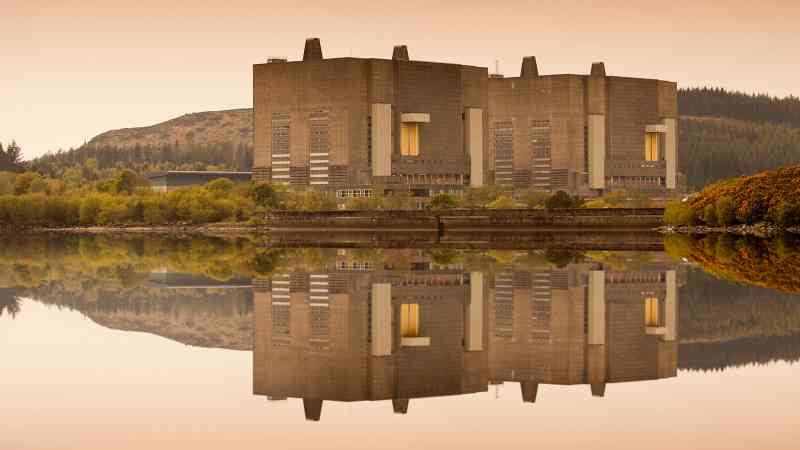Slap bang in the middle of Snowdonia national park, on the shore of a picturesque reservoir, sit the brutalist towers of the Trawsfynydd nuclear power station. Decommissioned in 1993, Trawsfynydd is at the crossroads of Britain’s nuclear past and future. The region is popular with visitors but lacks the high-skilled jobs that would lift wages. “It’s a beautiful area and tourism is fantastic, but … it doesn’t bring the quality jobs that would keep youngsters in the area,” said John Idris Jones, chairman of the local enterprise zone.
Trawsfynydd’s fortunes could be about to change. It has been proposed as a possible site for a new type of nuclear reactor to be built by a consortium led by Rolls-Royce. Small modular reactors (SMRs) offer the promise of a new fleet of power stations that could be produced in a factory, loaded on to lorries and then trucked around the country for installation on decommissioned nuclear sites.
The government believes these so-called “mini-nukes” will form a key part of its “green recovery” and is close to approving £215 million in funding to speed their development. The hope is that they could reduce the cost of nuclear power dramatically and help the UK to hit its target of net-zero emissions by 2050.
But nothing is ever simple with nuclear. Can this dream become reality?
The UK has 13 nuclear reactors at six sites, generating about 20 per cent of the country’s electricity. All but one are due to be decommissioned by the 2030s. In recent years, a number of international investors have pulled out of plans to develop plants over cost and financing. The only site under construction is Hinkley Point C in Somerset, which will have a capacity of 3.2GW. Hinkley is years behind schedule and likely to cost in the region of £23 billion. Further plants at Sizewell in Suffolk and Bradwell in Essex await the green light.
Enter Rolls
With large-scale nuclear projects under a cloud, the government has warmed to the idea of smaller, nimbler technology, such as the SMRs proposed by Rolls-Royce. The Derby-based company is better known for producing aircraft engines, but since the 1960s it has also been responsible for the reactors on Britain’s nuclear submarines. These pressurised water reactors (PWRs) will form the basis of the SMRs it proposes to build in the UK.
“Rolls-Royce has built lots of reactor cores,” said Mark Wenman, reader in nuclear materials at Imperial College London. The exact number of submarine reactors built by Rolls is a secret, but these types of PWR are well understood; Wenman estimates that they make up about 60 per cent of the world’s nuclear power stations. “Rolls-Royce knows how to build them. It’s not anything that’s very special or innovative, but it will generate electricity that’s low-carbon.”
The big selling point of SMRs is that they can be made on a production line, reducing the huge costs of a project such as Hinkley. Rolls claims they solve “the conundrum of how to create affordable energy, and more of it, with a lower carbon footprint”. It says the scheme could generate £52 billion of “economic benefit” by 2050. The company’s SMRs will have a price tag of about £2 billion each, once the initial costs of building the factory are out of the way. It is thought Rolls would need to make 16 before the programme could pay its way, with financial support from the government required for at least the first four units. The SMRs would have a capacity of 470MW — enough to power one million homes.
Because of the complexity around planning permission for nuclear plants, and the likelihood of local opposition, Rolls expects SMRs to be placed on the sites of existing stations, many of which are in remote areas by the sea, where they have access to the water they need for cooling. An SMR facility would take up the space of about two and a half football pitches, although some sites may have more than one reactor. The plants would use less radioactive material than a traditional plant, though disposal remains a problem. The UK has long-term plans to build a geological disposal facility that would one day store radioactive waste deep underground but this is still only a proposal and no site has been selected.
Critics of SMRs note there are few, if any, operating anywhere in the world. The American company Westinghouse is developing a lead-cooled reactor with 450MW capacity which won £10 million in UK government funding last year. NuScale, based in Oregon, is working on SMRs with an output of 77MW. But its first plant will not be operational until 2027. If the government gives the green light, Rolls will spend the next four years seeking approval from regulators while simultaneously building the first of a projected three factories in the UK. Company sources suggested the factories themselves could be a “levelling up” opportunity, bringing high-skilled jobs to the regions. It would take another four years for the first reactor to roll off the production line, pushing their start date into the next decade.
Nuclear challenged
Supporters of nuclear argue it provides reliable power when the wind is low or the sun does not shine. “The switch to electric vehicles, and the greater use of sophisticated data-processing technology, will require an increase in electricity consumption,” said Tim Yeo, the former Conservative MP and chairman of the New Nuclear Watch Institute. Too much reliance on intermittent renewables “runs the risk of outages and you might see some quite big spikes in price”, he added.

This claim is disputed. Stephen Thomas, professor of energy policy at Greenwich University, said the falling cost of wind and solar power, coupled with new technology to store energy off the grid for times when it is needed, made nuclear largely redundant. “It’s too expensive, takes too long to develop, and we can’t afford to wait for it,” he said.
A report by National Grid ESO (Electricity System Operator) this year envisaged at least two pathways to net zero by 2050 that did not rely on a large increase in nuclear. Instead, the gap in output would be made up by more renewable energy; more energy storage, in the form of batteries; and changing consumer behaviour to lower energy demand.
Funding the high cost of nuclear power stations has proved the undoing of projects in the past. For Sizewell C, the government is considering a “regulated asset base” (RAB) model, which would sprinkle the upfront costs of construction on to customers’ bills years before the plant actually produces electricity. This type of model has been used in large infrastructure projects such as the Thames Tideway and reduces the risk for investors and the builder of the plant — in this case, EDF. It would allow the French energy giant to avoid the crippling costs of finance it is bearing for Hinkley Point. The company is guaranteed a fixed price of £92.50 per megawatt hour (MW/h) for electricity produced from the plant for 35 years, but it has estimated that just £11 of that would cover the cost of construction. Around two-thirds is going on the cost of financing it in interest payments and the like.
Some campaigners argue that RAB is a “nuclear tax” on consumers. Writing for The Sunday Times online this weekend, Anthony Horowitz, the author, who is involved in the Stop Sizewell C group, said: “Is this the best time to be considering another stealth tax on electricity bills, particularly as the amount will almost certainly rise with the cost overruns and overspends for which the nuclear industry is notorious?”
For its SMRs, Rolls does not anticipate using RAB and instead is looking at traditional debt and equity financing after initial government help.
In north Wales, an area already familiar with the nuclear industry, Idris Jones is more focused on the benefits an SMR could bring to Trawsfynydd. He predicts up to 2,000 jobs in the building of any plant and up to 400 to operate it, before the indirect impact it would have. “It wouldn’t just affect the immediate vicinity, but it would benefit the whole of north Wales,” he said. “People in the area are supportive. The site is there, the electrical connections are there, the cooling water is there. Everything’s ready for a new development.”
